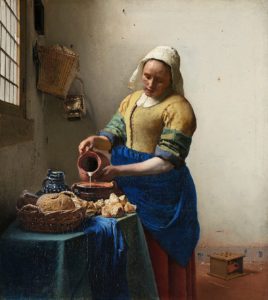Starting on February 10, 2023, the Rijksmuseum in Amsterdam will open an exhibit featuring 27 of the 35 known paintings by the Dutch Golden Age master Johannes Vermeer. It will be the largest Vermeer exhibition to date, reuniting many of his most recognizable masterpieces. The show will include the Rijksmuseum’s Milkmaid and the iconic Girl with a Pearl Earring from the Mauritshuis museum in The Hague. The last time these two Vermeer masterworks were together was in a show at the Mauritshuis in 1996. Furthermore, the Frick Collection in New York is sending its three Vermeer paintings from its inventory: Officer & Laughing Girl, Girl Interrupted at Her Music, and Mistress & Maid. This will be their first time leaving New York since they arrived over a century ago.
Being the largest Vermeer exhibition in recorded history will certainly draw crowds, but recent revelations about The Milkmaid will probably be another contributing factor to the exhibition’s predicted popularity. Vermeer has become so popular for several reasons. His works are few, which makes each individual painting very valuable. They offer a brief glimpse into Dutch domestic life, conveying a tranquility that can sometimes be missing from our own lives. But Vermeer is a particular favorite for many because people are still very much interested in his technique. He was a master of light, able to capture the slightest differences of illumination and shadow on the walls, within the folds of garments, refracted through glass, and dimmed through cloth drapes. The prevailing assumption for many years had been that Vermeer was incredibly meticulous, painstakingly poring over his canvas to get his interior scenes exactly as he wanted them. There are entire documentaries available (like the one made by Tim Jenison) where people test theories that he may have used some optical device like a camera obscura to help him create his works. But now, the discoveries made at the Rijksmuseum bring those assumptions into question.
Scans of The Milkmaid performed by Rijksmuseum conservators now show elements of the original work later painted over. It seems Vermeer originally planned for several ceramic jugs to hang on the wall behind the titular woman. Also, there was originally a woven basket on the floor in the lower right-hand corner of the painting. While it was originally assumed that Vermeer painted incredibly slowly to create a complete scene with few revisions, these new scans show something very different. That it’s likely that, according to the museum, “Vermeer first quickly painted the scene in light and dark tones before developing the detail.” While an artist adding or removing elements from an interior scene on a whim may not seem particularly noteworthy, it is actually eye-opening when it comes to Vermeer. Maybe this was just a one-time thing, or maybe this discovery will dramatically alter how academics and researchers view Johannes Vermeer’s works and techniques.

